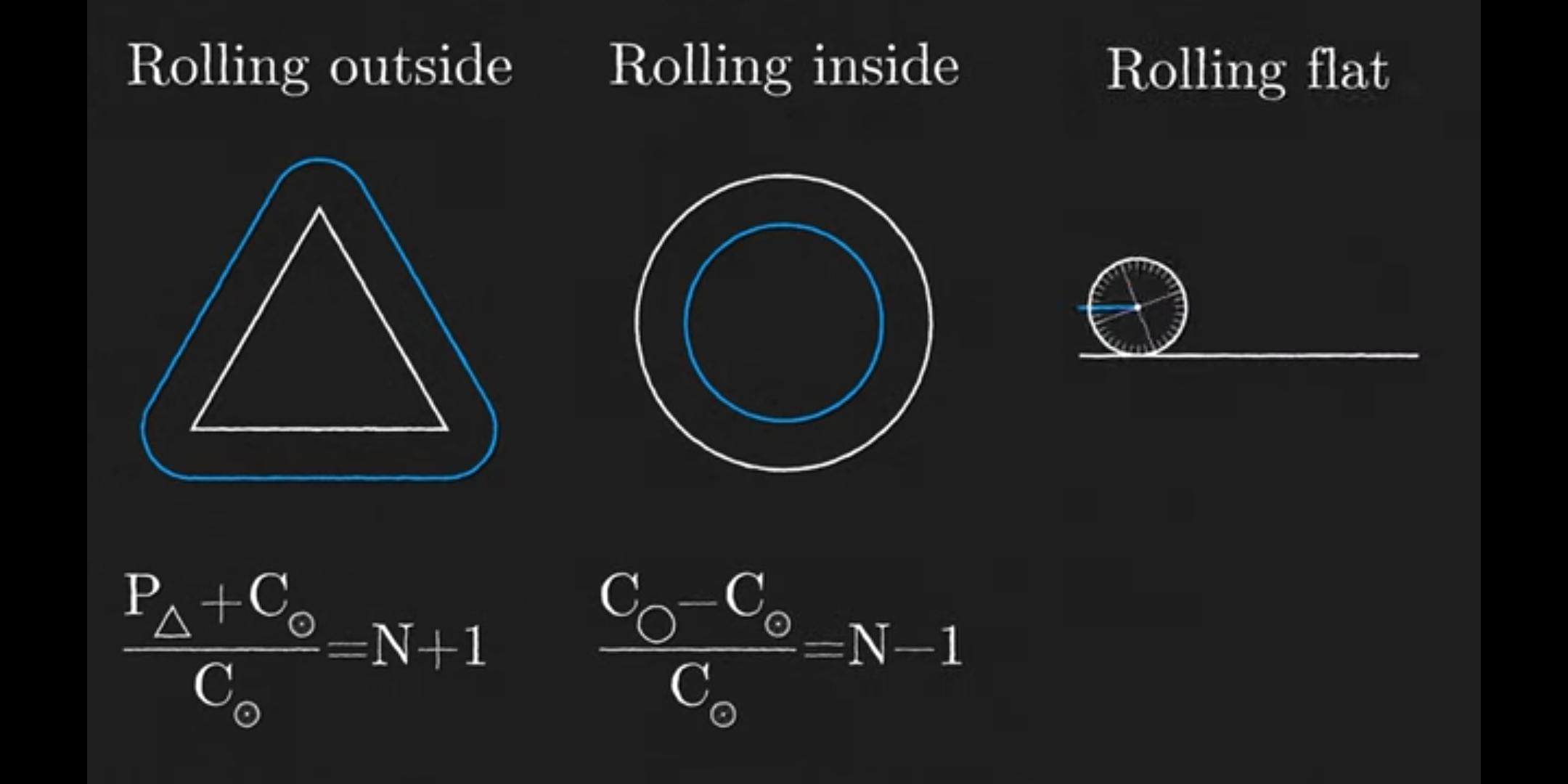this post was submitted on 01 Dec 2023
170 points (89.0% liked)
Videos
16434 readers
86 users here now
For sharing interesting videos from around the Web!
Rules
- Videos only
- Follow the global Mastodon.World rules and the Lemmy.World TOS while posting and commenting.
- Don't be a jerk
- No advertising
- No political videos, post those to !politicalvideos@lemmy.world instead.
- Avoid clickbait titles. (Tip: Use dearrow)
- Link directly to the video source and not for example an embedded video in an article or tracked sharing link.
- Duplicate posts may be removed
Note: bans may apply to both !videos@lemmy.world and !politicalvideos@lemmy.world
founded 2 years ago
MODERATORS
you are viewing a single comment's thread
view the rest of the comments
view the rest of the comments
I did not watch this video but did read about this math. Visualize the larger circle unwrapped into a flat line, and the smaller circle sliding along the length of the line so its bottom point is fixed to the line. You'll see the small circle never rotates. Now slide the small circle with a point fixed onto the large circle in the same way, and you'll see the small circle makes one complete rotation. That rotation happens in addition to the rotations you get from dividing the larger circumference by the smaller circumference, so the answer is 4 in this case
Satellite operators have to use this equation for orbits.
Wouldn't it be 3 = 6π/2π ?
if the path had been straight yeah, but the path itself rotates 360 degrees, which gives us an extra rotation
This is the comment that finally enlightened me
Thank you
This finally made it click. Thanks
Now that is mind-bending trickery! Having a degree in applied matha millennia ago did not help...
That's what you'd think, but there's an extra rotation involved in the act of the small circle moving around the larger circle rather than along a straight line, so it's (6π/2π) + 1
I just watched the video, that's really interesting. Thanks for the explanation
Watch the video, it's explained.
This should have been an article. What's the summary?
I summarized it above, there's an extra rotation included when the outer circle moves along the inner circle, essentially falling a bit with every roll forward. If the outer circle rolled along a straight line of the same length as the circumference of the inner circle, it would only roll 3 times, but moving around the circle instead adds exactly one extra rotation. That other gent says this is used in calculating orbits too, where you're also moving forward while constantly falling
I read an article about it. Everybody is doing a shit job of describing what happens. The outer circle naturally makes a full rotation as it travels around the inner one, as the path it follows goes around a full 360°, so that counts as one of the rotations it ends up making, which is in addition to the 3 due to travel around the circumference.
thank you, that was the comment that explained it for me
Thanks for letting me know! It was too frustrating to not share.
Add the radius together. If the circle is inside. B-A 3-1 = 2.
Does not compute
It’s in the video.
A circle with a radius of 2 and a circle with a radius of 3 would be 5 rotations.
First you said add the radii together, then you gave an example subtracting them, but either way this is incorrect. You divide the larger radius by the smaller radius and add 1
Not quite. With radius 2 and 3 circles, the outer circle would take 2.5 rotations to complete the revolution. You have to set the first circle radius to 1 (divide both radii by the lesser) and then add the radii to calculate the relative circumference of the circle drawn by the motion of the center of the outer circle, so the answer would be calculated like:
2/2 + 3/2 = 5/2 = 2.5
…?
Its not even remotely what you said. Its A/B+1 or A/B-1 for an interior loop.
edit: I didn't need to be this aggressive. It's VAGUELY what you said. its (A+B)/B. You have missed the /B part.. which is A/B + 1.
in the example you gave, for radius 2 and 3... it would be 3/2 + 1 or 2.5. Not 5 (off by a factor of 2 because /B)
They explain multiple ways to do it in the video. A circle with a radius of 2 and a circle with a radius of 3 would be 5.
No they don't
N is the ratio of the circles and its just +1 or -1 depending on outer or inner.
The center travels 2π per rotation but need to travel 8π because the path of the center of the small circle is a circle 4r the radius of the large circle plus the radius of the small circle. It would be three if the center of the small circle traveled along the edge of the larger circle but it's edge to edge.